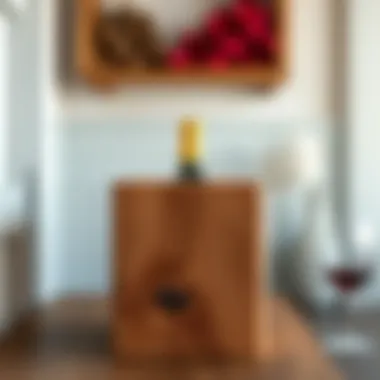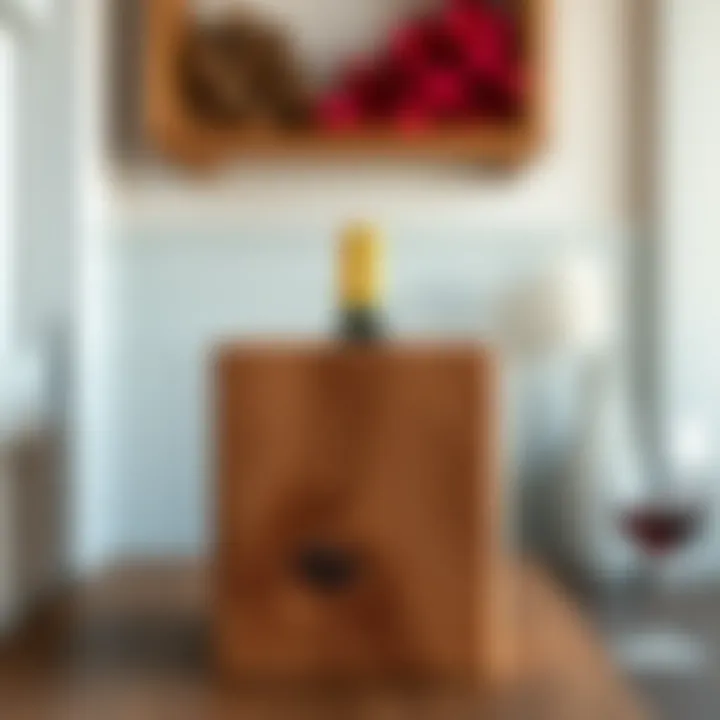The Art and Utility of Wood Wine Cubes


Intro
The world of interior design is a tapestry woven with diverse fabrics, colors, and textures. Among these elements, wood wine cubes have emerged as a captivating and functional furniture piece that speaks to both aesthetic sensibilities and practical needs. Whether you're a connoisseur of fine vintages or simply enjoy a glass of wine on occasion, understanding the intricate balance of design and functionality in wood wine cubes might just inspire you to rethink your wine storage solutions.
With a rich palette of woods and designs available, these cubes not only store your favorite bottles but also serve as a statement piece in any room. This article unfolds the layers of this fascinating topic, from current furniture trends to the specifics of selecting the right piece for your space. We’ll take an exploratory stroll through the specifics of craftsmanship, material choice, and the thoughtful maintenance required to keep these wooden gems in top condition.
Furniture Trends and Styles
Current Trends in Furniture Design
Today’s furniture trends highlight a strong preference for sustainability and natural materials. As homeowners seek to create spaces that feel warm and inviting, wood, particularly in its raw or minimally processed state, has regained prominence.
"Natural materials add warmth and depth to design while emphasizing sustainability."
In the realm of wine storage, wood wine cubes exemplify these trends beautifully. Sleek, minimalist designs prevail, allowing the natural beauty of the wood to shine without overwhelming the décor. Customization is also a key aspect, as many manufacturers offer bespoke options that cater to individual tastes.
Popular Furniture Styles and Their Characteristics
- Modern Scandinavian - Emphasizing simplicity, functionality, and craftsmanship, Scandinavian designs use light woods like birch or ash. Wood wine cubes in this style often feature clean lines and a focus on usability.
- Rustic - Characterized by a rough-hewn finish and an earthy appeal, rustic cubes often employ oak or reclaimed wood. They bring a certain charm and hominess that complements country or farmhouse interiors.
- Industrial - This style merges raw materials such as metal and wood. An industrial wood wine cube typically showcases distressed wood combined with metal accents, ideal for urban lofts or eclectic spaces.
- Contemporary - Featuring bold innovations, contemporary designs may incorporate mixed materials like glass or acrylic alongside wood. These cubes are often statement pieces, balancing artistic flair with functionality.
As these styles evolve, the allure of wood wine cubes remains anchored in their timeless nature. They bridge the gap between art and utility, proving that wine storage doesn’t have to be just functional but also a reflection of personal style.
Buying and Maintenance Guides
Essential Tips for Purchasing Furniture
Choosing the right wood wine cube involves considering several factors:
- Material Quality: Ascertain whether the wood is solid or engineered. Solid wood offers longevity, while engineered options might be more budget-friendly.
- Size and Configuration: Evaluate the space where the cube will reside. Look for dimensions compatible with your existing furniture layout.
- Finish: Whether painted, stained, or left natural, the finish can dramatically influence the overall look and feel.
- Functionality: Some cubes come with features like additional shelving or drawers. Think about what suits your wine storage needs best.
Maintenance and Care for Different Furniture Materials
Keeping your wood wine cube in pristine condition requires a little ongoing effort:
- Dust Regularly: Use a microfiber cloth to clean the surface. This prevents a buildup of dust that could scratch the wood.
- Avoid Harsh Chemicals: Cleaners with harsh chemicals can damage the wood finish. Stick to gentle products designed specifically for wood care.
- Control Humidity: Excess moisture can warp wood. Maintain a stable environment to prevent damage.
- Periodic Re-Oiling: Some finishes may require reapplication of oil or wax to maintain their luster and protect against scratches.
Incorporating wood wine cubes into your home décor not only addresses practical storage needs but also invites warmth and elegance into the space. By paying attention to the trends and characteristics, you can make informed choices that enhance the beauty and functionality of your home.
Intro to Wood Wine Cubes
In an age where aesthetics and functionality increasingly intertwine, wood wine cubes have emerged as more than just storage solutions. They signify a lifestyle choice, merging practicality with an appreciation for craftsmanship and design. Wine enthusiasts and casual drinkers alike are recognizing the unique potential of these cabinets, transforming both the act of storing wine and the personal space surrounding it.
Defining Wood Wine Cubes
When one talks about wood wine cubes, it’s essential to understand that these are not merely boxes with a purpose. They are well-crafted furniture pieces specifically designed to hold wine bottles in a manner that often showcases the bottles themselves. Typically made of high-quality wood, these cubes can come in various shapes and sizes, accommodating different volumes of wine and fitting seamlessly into diverse home interiors.
Their versatility does not end with just functionality; these cubes can serve as a centerpiece in a room, exuding warmth and rustic charm that metal or glass storage alternatives often lack. Consequently, choosing wood wine cubes can enhance the visual appeal of your living space, echoing a person’s style and love for wine.
Historical Context and Emergence
The emergence of wood wine cubes can be traced back to rustic wine cellars and traditional wine-making regions. Historically, wine was stored in wooden barrels, which imparted flavors to the aging process. As wine culture evolved, so did the means of its storage.
In the late 20th century, with the burgeoning popularity of wine and home entertaining, there came a shift towards more functional, yet artisanal wine storage solutions. Wood wine cubes began to emerge not only in homes but also in wine shops and restaurants, offering an eye-catching way to display collections.
"The transition from functional to aesthetic in wine storage is a testament to how far our appreciation for wine has come."
Today, these cubes represent a confluence of design and utility, their construction reflecting a blend of modern minimalist and classic rustic styles. They have captivated homeowners, designers, and decorators alike, becoming an essential item for anyone looking to elevate their wine storage experience.
By understanding the definitions and historical nuances of wood wine cubes, one can appreciate their role as both practical tools and decorative pieces within our homes. This intersection of utility and aesthetics sets the stage for a deeper exploration of craftsmanship, design variations, and functionality that will follow in subsequent sections.
The Craftsmanship Behind Wood Wine Cubes
In the realm of wood wine cubes, craftsmanship plays a pivotal role in ensuring both functionality and aesthetic appeal. Every curve and joint in a wine cube reflects the skill of the artisan, as well as the intended use – to house and display some of the finest wines. The material choice, construction techniques, and finishing processes all contribute significantly to the overall quality and longevity of the pieces. As such, examining the craftsmanship involved not only provides insight into the wine cube's functionality but also enhances our appreciation for these remarkable creations.
Types of Wood Used


Hardwoods vs. Softwoods
When diving into the types of wood suitable for crafting wine cubes, it’s crucial to understand the difference between hardwoods and softwoods. Hardwoods, sourced from deciduous trees, are typically denser and more durable compared to softwoods that come from conifers. This density translates into better resistance to wear and tear, making hardwoods a favored choice for artisans looking to create long-lasting wine cubes.
On the other hand, softwoods have their own merit, often being lighter and more workable, making them easier to shape during the construction process. A unique trait of hardwoods is their grain patterns, which lend themselves well to creating visually stunning pieces, while softwoods can be less visually appealing. In the world of wood wine cubes, the choice often comes down to a balance between aesthetics and practicality, with hardwoods generally being the more popular selection due to their longevity.
Common Wood Species for Wine Cubes
Several wood species have become mainstream for crafting wine cubes, each bringing its own characteristic flavor to the design. Oak, for instance, is renowned for its porous nature – a feature that enhances wine aging while adding exquisite detail to the cube’s appearance. Maple, with its fine grain, is often chosen for its smooth finish and resistance to scratches, ensuring that the cube maintains its appearance over time.
Another notable mention is walnut, prized for its deep, rich color and strength. It provides a sophisticated look, enhancing the overall decor of any room. While each wood species has its advantages, considerations like cost, availability, and impact on wine flavor can affect the final decision. Ultimately, the choice of wood will influence not just the cube’s functionality but its role as a statement piece in a home.
Techniques in Construction
Joinery Methods
Joinery methods are foundational when it comes to creating robust wood wine cubes. These methods, which include dovetail joints or mortise and tenon joints, contribute significantly to the structural integrity of the cubes. Such joinery techniques are time-consuming but result in strong, seamless connections between different parts of the cube.
The specific characteristics of these joints add a level of craftsmanship that is often appreciated by discerning wine lovers. In terms of benefits, quality joinery ensures that the cubes can withstand the weight and potential vibration from stored bottles, while also providing an attractive look that showcases the joiner’s skill. Nevertheless, the complexity of advanced joinery can increase production costs and time, which are important considerations for manufacturers.
Finishing Touches
Finishing touches in woodcrafting can make or break the final presentation of wine cubes. This encompasses everything from sanding and staining to applying protective sealants. A smooth finish not only enhances the aesthetic appeal, giving the cube a rich, luxurious feel, but also protects the wood from moisture and other elements that could cause damage over time.
Moreover, the finishing processes bring out the natural beauty of the wood grain and can dramatically influence colors, providing designers with a broad palette for customization. Yet, the downside lies in the fact that some finishes may alter the taste of wines, creating a challenge for the artisan to balance beauty and function.
In summary, understanding the craftsmanship behind wood wine cubes sheds light on the immense skill and consideration required in their creation. The types of wood, joinery methods, and finishing touches all contribute to a final product that is not just a storage solution but also a centerpiece in home decor. This appreciation for craftsmanship is essential for any homeowner or enthusiast looking to elevate their wine storage experience.
Design Variations of Wood Wine Cubes
When it comes to wood wine cubes, this aspect holds a treasure trove of opportunities for both aesthetic expression and functional utility. Design variations can make a world of difference, enabling homeowners and decorators to align their choices perfectly with their personal taste and interior decor themes. From contemporary finishes that scream modernity to classic styles exuding warmth and tradition, the right design can elevate a simple wine storage solution into a stunning focal point.
Contemporary Designs
Contemporary wood wine cubes often embrace sleek lines and minimalistic aesthetics. These designs prioritize functionality while showcasing the beauty of the natural wood grain. Many contemporary models feature modular structures, allowing users to expand or rearrange their storage as their wine collection grows.
One typical characteristic of these designs is the use of lighter woods such as birch or maple, which fit seamlessly into modern, airy spaces. They often include integrated lighting to highlight the bottles, transforming wine storage into an art display. Additionally, contemporary designs might even incorporate metal brackets or glass elements to add a touch of sophistication. This fusion of materials reflects a harmonious blend of natural and industrial styles.
Traditional Aesthetics
On the flip side, traditional wood wine cubes show off an entirely different charm. They often exhibit rich, darker woods like mahogany or walnut, providing a warm and classic atmosphere. These cubes regularly showcase intricate carving and embellishments, harking back to a time when craftsmanship was paramount.
Traditional designs often prioritize function that aligns with age-old practices, such as sloping shelves for optimal bottle positioning, or locking compartments for enhanced security. For wine enthusiasts who value heritage, a traditional design echoes the roots of wine culture and invites conversation about the stories tied to each bottle.
Customization Options
Customization stands out as an essential component of today's wood wine cube designs, allowing consumers to tailor their storage to personal specifications and preferences. It’s all about making the piece truly yours, which can dramatically amplify the aesthetic cohesion of your dining or living area. The flexibility in customization can manifest in various forms, including personalized engravings and unique color and finish choices.
Personalized Engravings
The charm of personalized engravings lies in their ability to evoke memories and sentiments. Laser engraving services can carve anything from a cherished family name to the date someone first discovered their passion for wine. This not only adds a touch of individuality but can serve as a conversation starter at gatherings.
Engravings help in creating a unique identity for the wine cube, transforming an item into a meaningful artifact. The beauty of personalized engravings is that they are deeply personal yet universally cherished, making them a popular choice for gifts or commemorative purposes.
Color and Finish Choices
Color and finish options are another way custom wood wine cubes can stand out. The finish can radically change the piece’s look, ranging from natural wood oils that give a rustic feel to high-gloss finishes that reflect modernity. Various stains can accentuate the wood grain or even alter the hue completely, matching perfectly with the owner’s wall or existing furniture.
The ability to choose a finish means homeowners can enhance or diminish the natural features of the wood. For instance, a matte finish can lend a more understated elegance, while a shiny finish adds vibrancy and a contemporary flair. Each choice carries with it its own advantages and possible downsides; a gloss finish might require more upkeep to maintain its look, while natural finishes often breathe more naturally but may alter with age.
In the ever-evolving landscape of wine storage, wood wine cubes offer a delightful intersection of form and function. Their design variations serve not only to house your prized bottles but to narrate a story about your style, values, and experiences—all while enriching the atmosphere of your home.
Functional Aspects of Wood Wine Cubes
Understanding the functional benefits of wood wine cubes is crucial for anyone interested in optimizing their wine storage solutions. Beyond aesthetics, these cubes serve vital roles in preserving the quality of wine, enhancing home decor, and effectively making use of available space.


Storage Efficiency
Efficient storage can significantly affect how one enjoys and consumes wine. Wood wine cubes are designed to keep bottles organized while effectively using the space they occupy.
Space Optimization Techniques
When it comes to maximizing space, wood wine cubes offer clever solutions. Their design allows them to fit snugly against walls or in corners, utilizing areas that may otherwise go unused.
- Customizable sizes and shapes can adapt to the environment of the home.
- Stackable features enable vertical storage, minimizing the floor space needed.
The key characteristic of space optimization techniques found in wood wine cubes is their modular design. This versatility allows for easy integration into various layouts and styles of homes, making them an especially popular choice among homeowners. However, their unique feature lies in the balance they strike between aesthetics and functionality. They not only store wine but also enhance the overall look of a space, creating a harmonious blend between utility and design.
Overall, the main advantage is that efficient space utilization can also help reduce clutter, contributing to a more organized living space.
Preventing Wine Damage
The considerations surrounding wine damage prevention are essential for maintaining the quality of stored wines. Wood wine cubes are not just storage units; they play a direct role in protecting bottles from common damages that could compromise the contents.
- They typically provide a stable environment that minimizes movement and exposure to vibrations.
- The materials used often help insulate the wine from temperature changes.
One of the standout features of these storage options is their ability to provide a consistent and protective environment for bottles. The key characteristic of preventing wine damage lies in how they reduce fluctuations in temperature and humidity, which can adversely affect wine. The engineered structure offers robust protection, making them a smart investment for wine enthusiasts. Still, it's important to be mindful of humidity levels, as excessive moisture can lead to mold or deterioration of corks.
Thus, there's a delicate balance between securing the optimal conditions while also ensuring the aesthetics align with the homeowner's personal style.
Integration into Home Decor
Wood wine cubes also function as significant decor elements. Their natural textures and colors can resonate with various design aesthetics, making them appealing for many homeowners.
Complementing Existing Furniture
These wine cubes serve more than just a storage purpose. They often complement existing furniture, bringing a sense of cohesion and style to the room.
- They can match wood tones from other furniture, enhancing the overall theme of the decor.
- The natural grain and fragrance of wood add an organic appeal that can soften modern designs.
The unique feature of wood wine cubes lies in their ability to serve as functional art pieces. This characteristic helps bridge the gap between utility and style, showing that storage solutions do not have to be hidden away. One downside to consider, however, is ensuring that the wood type harmonizes with existing decor, which can present a challenge if not carefully selected.
Styling Tips for Placement
How wine cubes are styled in a home can greatly influence the ambience of a space. Thoughtful placement allows them to act as focal points or subtle details within a room.
- Arranging them on an accent wall or near dining areas can enhance their visibility and function.
- Using them as part of a vignette with other decorative items can elevate the overall decor.
The main characteristic of this aspect is the flexibility of placement options. Many homeowners appreciate that wood wine cubes can align with various themes, from rustic farmhouse settings to sleek contemporary designs. However, one must be cautious about overcrowding surfaces, as it can detract from the clean aesthetic that these cubes aim to provide.
Proper placement can create a balance that draws the eye without feeling cluttered or overrun with decor.
In summary, wood wine cubes not only provide essential storage solutions but also enhance the aesthetic grace of any space they occupy. By carefully considering their functional aspects, one can significantly elevate wine storage practices while enjoying the decorative benefits they bring.
Maintenance and Care of Wood Wine Cubes
Taking good care of wood wine cubes is as crucial as the selection of the bottles they house. Maintaining their integrity and charm not only ensures that they last for years but also keeps them looking splendid in your living space. With proper maintenance and care, wood wine cubes can become a lasting centerpiece that blends style and functionality in your home.
Routine Cleaning Practices
Cleaning your wood wine cubes requires a gentle yet effective approach. The aim is to remove dust and dirt while preserving the wood's finish. A few simple practices can go a long way:
- Use a soft, damp cloth to wipe the surfaces regularly. Avoid soaking the cloth; using too much moisture can damage the wood's integrity over time.
- For stubborn stains, a mild detergent mixed with warm water can be used, but ensure that no excess water is left on the wood.
- Be sure to dry any damp areas immediately with a dry cloth to prevent long-term moisture problems.
- An occasional application of a specific wood cleaner will help enhance the finish and protect the surface from wear and tear.
These practices will not only keep the wine cubes clean but will also help in preserving their beauty, ensuring they remain a perfect home for your wine collection.
Long-Term Care Strategies
To enhance the longevity of wood wine cubes, invest time in long-term care strategies. Taking proactive measures can effectively prevent common issues associated with natural wood.
Preventing Warping and Cracking


One of the major concerns for wooden furniture, including wine cubes, is warping and cracking that can occur due to fluctuations in temperature and humidity. Here’s how to tackle this:
- Control Environment: Keep your wine cubes away from direct sunlight and heat sources like radiators or fireplaces. Sudden temperature shifts can lead to wood expanding and contracting, leading to cracks.
- Use Humidifiers: In dry climates, consider using a humidifier during colder seasons. This can prevent the wood from drying out too much, reducing the chances of cracking.
- Regular Inspections: Carry out regular inspections for any early signs of warping. A quick adjustment can save you much trouble later.
Implementing these strategies creates a protective environment, ensuring that the wood maintains both its functionality and visual appeal.
Maintaining Aesthetic Appeal
Keeping wood wine cubes looking their best is not only about cleanliness but also aesthetics. The beauty of the wood can fade over time if neglected. Here are some effective tips:
- Polishing: Using a suitable wood polish can restore shine and offer a protective layer against dust and dirt.
- Avoiding Harsh Chemicals: The use of abrasive cleaners can strip away the wood’s protective finish. Opt for natural cleaning methods to preserve the original aesthetics.
- Handle with Care: Always handle your wine cubes gently. Avoid bumping them against hard surfaces that could scratch or chip the wood.
These strategies play an crucial role in maintaining not just the wood’s surface but also prolonging the relationship you have with your furniture. A well-cared-for wood wine cube becomes a conversation starter while showcasing your collection beautifully.
In summary, taking care of wood wine cubes is about understanding their material and choosing appropriate maintenance methods that suit their specific needs. With simple routine practices and long-term strategies, these functional art pieces can provide elegance and utility for many years.
Assessing the Drawbacks of Wood Wine Cubes
When discussing wood wine cubes, it’s essential to take a moment to step back and evaluate any potential downsides that may accompany their aesthetic and functional benefits. With a growing trend around natural materials in design, there’s a valid conversation to be had about the quality issues linked to their manufacturing and the environmental impacts of sourcing the wood. Engaging with these topics not only enriches our understanding of wine storage solutions but also helps homeowners and decorators make informed decisions.
Potential Quality Issues
Quality can vary significantly among wood wine cubes available on the market. Here are some important considerations:
- Material Variability: Not all woods respond the same way when it comes to humidity and temperature fluctuations. For example, cheaper plywood options might not hold up as well as solid oak or walnut, leading to issues with structural integrity over time.
- Finish and Sealing: The finish applied to wood cubes can also make or break their durability. Some finishes may wear off quicker or might not provide adequate protection against moisture that can lead to warping or mold growth.
- Craftsmanship: When it comes to craftsmanship, not all producers adhere to the same standards. Poor joinery may lead to loose connections, compromising both the appearance and functionality of the product. Moreover, the lack of attention in finishing can lead to rough edges, which don’t just look bad but can also snag or damage wine bottles.
Environmental Considerations
Wood sourcing is a critical topic in the discussion surrounding wood wine cubes, as both sustainability and ecological impact intertwine with consumer choices.
Sustainability of Wood Sourcing
Understanding the sustainability of wood sourcing is paramount. The key characteristic here lies in whether the wood is harvested from responsibly managed forests.
- Responsible Practices: Woods that come from sustainably managed forests, like those certified by the Forest Stewardship Council, ensure that tree removal does not contribute to deforestation.
- Unique Features: Sustainable sourcing often denotes careful planning with regard to local ecosystems, offering long-term advantages for both producers and consumers. Choosing products that prioritize sustainability can create pressure for less responsible producers to clean up their act, essentially influencing a shift toward eco-friendly production methods.
Impact on Ecosystems
The impact on ecosystems is another vital aspect when assessing wood wine cubes.
- Biodiversity Threats: Unsustainable harvesting can lead to loss of biodiversity. For instance, clear-cutting practices in certain regions affect not only the trees but entire animal habitats.
- Local Communities: Neglecting to consider how wood sourcing affects local livelihoods poses ethical questions, particularly in nations where communities rely on forests for their economic stability.
- Potential Advantages: On the flip side, supporting sustainably sourced wood could benefit areas economically, promoting stewardship of forests while ensuring sustainable jobs in timber production.
All in all, it's important to balance the aesthetic appeal and functionality of wood wine cubes with these considerations. Choosing wisely doesn't just contribute to an individual's design narrative; it also supports a broader ecological and ethical framework. As a consumer, asking questions about sourcing and quality can guide your purchases toward options that align with a thought-out approach to both style and sustainability.
"When we choose wisely, we not only elevate our own homes but also contribute to the well-being of our planet."
Ultimately, confronting the drawbacks helps to foster a well-rounded understanding of wood wine cubes, a piece that sits both on the dining table and within a more significant environmental context.
Epilogue: Evaluating the Role of Wood Wine Cubes in Modern Decor
In wrapping up the discussion about wood wine cubes, it's important to underscore their multifaceted role in contemporary home aesthetics. These artisanal storage solutions transcend mere function, blending seamlessly into a variety of interior styles. Their presence can be as subtle as a whisper or as bold as a statement piece, depending on the craftsmanship and design nuances.
The beauty of wood wine cubes lies not only in their ability to house bottles but also to enhance the visual appeal of any space. For homeowners and decorators, they serve as an effective bridge between practicality and art, embodying a tactile warmth that many metal or glass alternatives lack. Gone are the days when wine storage was relegated to dark cupboards; modern designs invite wine cubes into living rooms and dining areas, turning them into focal points.
Furthermore, the environmental considerations of wood sourcing mean that selecting responsibly harvested materials lends integrity to the aesthetic. This is not an insignificant factor, especially among consumers who are increasingly aware of their ecological footprint; thus, wood wine cubes represent a thoughtful, stylish choice for those who value sustainability.
For retailers and designers, integrating wood wine cubes into their displays can create an inviting atmosphere that resonates with customers. It sparks conversations and cultivates a sense of community and hospitality, elements that are essential in today's market. It's a statement about lifestyle that implies a deeper appreciation for the finer things, enticing buyers to envision these pieces as part of their everyday lives.
"The inclusion of wood wine cubes in décor is like adding a splash of personality to a room—suddenly, it’s not just about the wine; it’s about the experience."
As we advance into increasingly innovative interior designs, wood wine cubes are likely to evolve as well. The balance between function, sustainability, and aesthetics will shape their future. Homeowners looking to pair practicality with style will find that these cubes not only hold wine but also contribute to a narrative of taste and sophistication.
Summary of Key Insights
In summarizing the key insights gathered, several points resonate with clarity:
- Aesthetic Appeal: Wood wine cubes provide a natural beauty that enhances living spaces. Their rich textures and warm tones create a welcoming atmosphere.
- Functional Versatility: These cubes are more than storage; they are decorative objects that can fit various designs—from minimalist to rustic.
- Environmental Impact: Responsibly sourced wood promotes sustainability, appealing to eco-conscious consumers.
- Cultural Significance: Incorporating wood wine cubes can elevate the social dynamics of a space, inviting more interactions and shared experiences over a glass of wine.
Future Trends in Wine Storage Solutions
As we look forward, several trends are emerging in the world of wine storage that could influence how we view wood wine cubes:
- Technological Integration: Smart wine cabinets that regulate temperature and humidity are on the rise. However, wood wine cubes can still complement these high-tech solutions by enhancing the overall decor.
- Minimalist Aesthetic: With the ongoing trend towards simplified living, businesses might start creating more streamlined and sleek versions of wine cubes, appealing to those who prefer clean lines.
- Customization: The demand for personalized products is only going to grow. Wood wine cubes could see an expansion in bespoke options, from unique engravings to innovative finishes.
- Sustainability Focus: As awareness about responsible sourcing continues to grow, manufacturers may increasingly prioritize sustainable woods and eco-friendly treatments, making wood wine cubes a staple for conscientious consumers.







